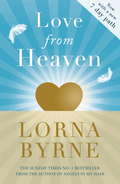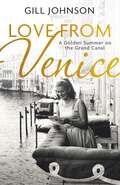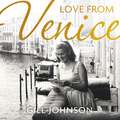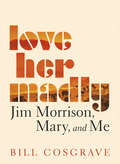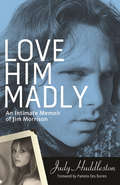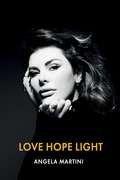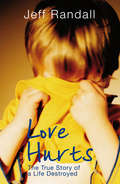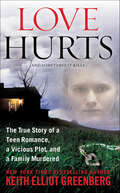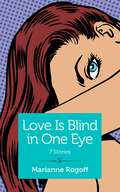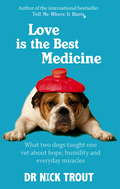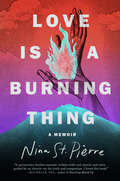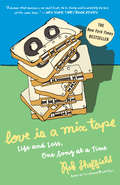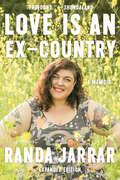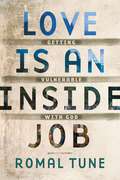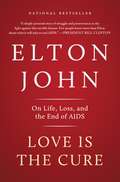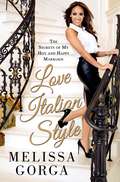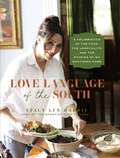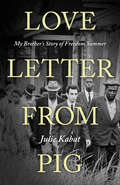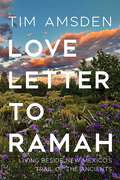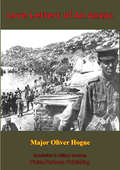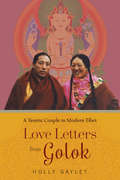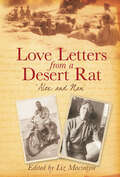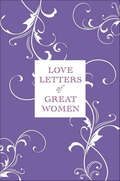- Table View
- List View
Love From Heaven: Now includes a 7 day path to bring more love into your life
by Lorna ByrneHow to bring more love into your life by the Sunday Times number one bestselling author of Stairways to Heaven and A Message of Hope from the Angels.Lorna Byrne has become a bestselling author around the world because she sees angels as clearly as the rest of us see human beings. Now she reveals that she also sees love as a physical force. What Lorna has seen has led her to develop a 7 day path to help us all change our lives. She says:'The more we love ourselves the more we can love others. If only we release a little more of the pure love we have locked away inside of us we will be much happier, less judgmental and feel much more fulfilled. Our lives and those of people around us would be transformed.'
Love From Venice: A golden summer on the Grand Canal
by Gill JohnsonIn the summer of 1957, rebelling against her family and anxious to impress an admirer who had moved to Paris, Gill Johnson, aged twenty-five, gave up her comfortable job at the National Gallery in London and travelled to Venice to take up a job teaching English to an aristocratic Italian family. Love from Venice is her vivid evocation of that summer, the last hurrah of the European Grand Tour, when the international jet set lit upon the city for their fun. Drawing on letters that she wrote to David Ross, her admirer and correspondent, and to her parents in London, Johnson describes her life as she flits from palazzo to Lido to palazzo. Absorbed into the social whirl of the super-rich, how do her feelings for her love begin to change?This is a moving and witty memoir of a young woman coming to terms with her own feelings and destiny, and learning about different aspects of love from the people she meets, all set in high-season Venice in a halcyon age.
Love From Venice: A golden summer on the Grand Canal
by Gill JohnsonA charming, funny and glamorous memoir and love-story, about a summer in 1957 in Venice, working for an aristocratic Italian family.In the summer of 1957, anxious to impress an admirer who had moved to Paris, while rebelling against her family, Gill Johnson, aged twenty-five, gave up her comfortable job at the National Gallery in London and travelled to Venice to take up a job teaching English to an aristocratic Italian family. Love from Venice is her vivid evocation of that summer, the last hurrah of the European Grand Tour, when the international jet set lit upon the city for their fun. Johnson describes (including through original letters written to her love in Paris) her life flitting from palazzo to Lido to palazzo, and how her feelings for him grow, while she becomes absorbed into the social whirl of the super-rich. It is a moving and witty memoir of a young woman coming to terms with her own feelings and destiny, and learning about different aspects of love from the people she meets, all set in high-season Venice in a halcyon time. By the end, Johnson discovers if the scabrous excesses of fabulous wealth can divert the course of true love.(P)2024 Hodder & Stoughton Limited
Love From Venice: A golden summer on the Grand Canal
by Gill JohnsonIn the summer of 1957, rebelling against her family and anxious to impress an admirer who had moved to Paris, Gill Johnson, aged twenty-five, gave up her comfortable job at the National Gallery in London and travelled to Venice to take up a job teaching English to an aristocratic Italian family. Love from Venice is her vivid evocation of that summer, the last hurrah of the European Grand Tour, when the international jet set lit upon the city for their fun. Drawing on letters that she wrote to David Ross, her admirer and correspondent, and to her parents in London, Johnson describes her life as she flits from palazzo to Lido to palazzo. Absorbed into the social whirl of the super-rich, how do her feelings for her love begin to change?This is a moving and witty memoir of a young woman coming to terms with her own feelings and destiny, and learning about different aspects of love from the people she meets, all set in high-season Venice in a halcyon age.
Love Her Madly: Jim Morrison, Mary, and Me
by Bill CosgraveA riveting memoir that works its magic like a slow-acting drug, revealing the story of Jim Morrison’s first love, a long-lost friendship, and the man who existed before the Doors. In the spring of 1965, Bill Cosgrave was smuggled across the border into the United States after receiving an irresistible invitation from his captivating friend Mary Werbelow. When he made it to her apartment in Los Angeles, Mary introduced Bill to her boyfriend, Jim Morrison. The two young men quickly bonded. When Jim and Mary’s relationship faltered, Jim headed for Venice beach with his notebook. Bill and Jim spent endless days together, enjoying the aimlessness of their youth and the freedom of the times, fuelled by Jim's unlimited supply of dope. Jim’s writing would morph into iconic hit songs, rocketing him to international fame as the hypnotic lead singer of the Doors. Beautiful Mary would set off on her own journey. After years of futile searching, Bill finally tracks down the woman he had secretly loved. He’s dying to know where her life has taken her and stunned by what he discovers.
Love Him Madly: An Intimate Memoir of Jim Morrison
by Pamela Des Barres Judy HuddlestonChronicling a young woman's four-year relationship with the lead singer of the Doors, this intensely intimate memoir provides a direct and unprecedented view of the late-1960s Los Angeles subculture. When Judy Huddleston's parents got divorced, she spent her last year of high school attending concerts. Transformed from a perceptive child into a rebellious teenager bent on attracting boys and fueled by psychedelics, she had lost her sense of self. That's when Jim Morrison came into her life. Honest, funny and direct, Huddleston provides an emotional portrayal of an unbalanced sexual relationship with a man whose demons haunted everyone he knew, while offering an even-handed portrait of Jim as a complex human being. Written in the idealistic and simultaneously jaded voice of a teenager, this is a tale of sex, obsession, misplaced spirituality, and an unforgettable fall from innocence.
Love Hope Light
by Angela MartiniAs much a tribute to Angela Martini's beloved mother as it is a personal memoir, Love. Hope. Light. is a multigenerational story of tenacity and the resilient power of love and family to overcome adversity. "My mother’s name is Nexhmije Ibrahimi Nussbaumer, and I am a living testament to her philosophies. Chief among them is her belief that nothing is finished until there is a happy ending—until you reach the light.” As a young girl growing up in Albania, Angela is insulated from the poverty and rising political tensions in her homeland by her mother’s loving, protective presence. But when Angela is nine years old, a series of events is set in motion that will forever change the course of her life—as well as her mother’s. Fearing for her daughter’s safety, Angela’s mother, Nexhi, makes the heartrending decision to send Angela to live with her father in Switzerland, where he had fled a few years earlier once Communism began to collapse. With her characteristic determination and courage, Nexhi overcomes many obstacles to finally reunite with Angela—months later and under much different circumstances than either could have imagined. Her life’s path is changed yet again when she decides to take German-language classes to help her integrate into Swiss culture. A natural and brilliant teacher, Nexhi then uses her hard-won knowledge to help other displaced women learn the language, in turn bolstering their confidence and emboldening them to start over and make new lives for themselves and their families. Reflecting on the lessons of her childhood and the wonderful example set before her, Angela is inspired by her mother’s efforts to bridge the divide between cultures, a lifetime of work that will have a lasting legacy, and by her abiding belief in love despite being married three times—twice to the same man! As much a tribute to the author’s beloved mother as it is a personal memoir, Love. Hope. Light. is a multigenerational story of tenacity and the resilient power of love and family to overcome adversity. “My mother’s life experiences have shown me that I must not cower before the unknown. Being fearless means seizing opportunities wherever they exist. Being fearless means never allowing people or circumstances to get in the way of your goals. Being fearless means loving like you’ve never been hurt before. Being fearless means forging a path through darkness to arrive at the light.”
Love Hurts: The True Story of a Life Destroyed
by Jeff Randall'A few seconds ago, I wanted to die. Now I know the reality is I just don't want to live. I never have from the moment I started falling, twenty-one and a half years ago. I'm alive. Shit.'Jeff Randall originally wrote his memoir by hand, the ink spattering on the page whenever he was writing about something painful and looping beautifully whenever he was recalling happier moments. He wrote it in a matter of weeks and delivered it to his estranged wife in an attempt to explain the demons that had haunted him for so long and that had been responsible for destroying their relationship.Love Hurts is the powerful true story of a boy whose tormented childhood was characterised by violence and isolation. He was raised in a fragmented, chaotic family, in a world where debt and poverty were the norm. From a young age, he yearned to escape but was sucked into an ever-decreasing spiral of bad choices and self-loathing.This brutally honest book charts the life of a boy who just wanted to be loved. And by confronting the nightmare of his childhood and coming to terms with his past, he has learned to love himself.
Love Hurts: The True Story of a Teen Romance, a Vicious Plot, and a Family Murdered (St. Martin's True Crime Library)
by Keith Elliot GreenbergFrom a New York Times–bestselling author—a true crime story of a Texas teen&’s 2008 plot to murder her parents for not approving of her boyfriend.&“Readers will be haunted by Greenberg&’s . . . eminently readable true crime tale.&”—Publishers Weekly Alba, Texas. In 2008, Terry Caffey, a home health care aide and aspiring preacher, was asleep in his bedroom when he woke up to a barrage of bullets. His wife, Penny, was killed instantly. With blood pouring from five bullet wounds, among other serious injuries, Terry tried—but failed—to save his two youngest children before crawling out of his burning house. Meanwhile, Terry&’s sixteen-year-old daughter, Erin, was missing… Once Erin was found by local authorities, she claimed she had been kidnapped—but could not remember the details. It wasn&’t until Terry was fully conscious that he could explain what had really happened: He&’d been shot, point-blank, by two young men. One of them he did not know; the other was Charlie James Wilkinson. Charlie was Erin&’s nineteen-year-old boyfriend, forbidden from entering the Caffey home. Until Erin helped Charlie come up with a plan to do away with her disapproving parents once and for all . . . Please note: This ebook edition does not contain photos that appeared in the print edition.
Love Is Blind in One Eye: 7 Stories
by Marianne RogoffIn these linked stories Jewel navigates the stage of life between 25 and 45, from the day she finds a body on a wild California beach to crossroads encounters with mystics, lovers, beggars, surgeons, and sailors on the shores of Maui and streets of San Miguel de Allende, Lisbon, Larkspur, Mill Valley, and Barcelona. Falling in love, whether with the one she marries, her newborn babies, total strangers, or the places she goes, calls forth conflicting sensations: ease/excitement, pleasure/danger, attachment/release. One eye sees and the other is blind as Jewel learns to love and grieve by staying in motion, finding and losing her way in the crowds and landscapes, heart cracked open.
Love Is The Best Medicine: What two dogs taught one vet about hope, humility and everyday miracles
by Dr Nick TroutBritish vet, Nick Trout, a modern day James Herriot working in Boston, USA, returns with a completely captivating true story.After exposing the fascinating life of a vet in his previous book, Trout now delves into rich emotional territory with the story of two dogs who have had a big impact in his career. Helen was found abandoned in a restaurant parking lot one rainy night, and despite her mangy condition, a couple falls in love with her. But just as she is rescued from the streets, a tumor is discovered and she's given a devastating prognosis. Chloe is suffering from chronic leg fractures which devastate her owner. Enter Dr Trout, who presides over what should be routine surgeries, until the unthinkable happens.LOVE IS THE BEST MEDICINE immerses readers in the true life drama of saving dearly loved pets, and underscores the incredible responsibility Nick carries as their healer. Fresh, charming, and intensely affecting, it's a one of a kind story.
Love Is a Burning Thing: A Memoir
by Nina St. PierreA riveting memoir about a daughter&’s investigation into the wirings of her loving, unpredictable mother: a woman who lived her life in pursuit of the divine, and who started two big fires, decades apart. Ten years before Nina was born, her mother lit herself on fire in a dual suicide attempt. During her recovery in the burn-unit, a nurse initiated her into Transcendental Meditation. From that day on, her mother's pain became intertwined with the pursuit of enlightenment. Growing up, Nina longed for a normal life; instead, she and her brother were at the whims of their mother, who chased ascension up and down the state of California, swapping out spiritual practices as often as apartments. When they finally settled at the foot of a mountain—reputed to be cosmic—in Northern California, Nina hoped life would stabilize. But after another fire, and a tragic fallout, she was forced to confront the shadow side of her mother's mystical narratives. With obsessive dedication, Nina began to knit together the truth that would eventually release her. In Love Is a Burning Thing, Nina interrogates what happens to those undiagnosed and unseen. This is a transfixing, moving portrait of a mother-daughter relationship that also examines mental health, stigma, poverty, and gender—and the role that spirituality plays within each. Nina&’s writing skirts the mystical, untangles it, and ultimately illuminates it with brilliance.
Love Is a Mix Tape: Life, Loss, and What I Listened To
by Rob Sheffield&“The happiest, saddest, sweetest book about rock &‘n&’ roll that I&’ve ever experienced.&”—Chuck Klosterman Mix tapes: We all have our favorites. Stick one into a deck, press play, and you&’re instantly transported to another time in your life. For Rob Sheffield, that time was one of miraculous love and unbearable grief. A time that spanned seven years, it started when he met the girl of his dreams, and ended when he watched her die in his arms. Using the listings of fifteen of his favorite mix tapes, Rob shows that the power of music to build a bridge between people is stronger than death. You&’ll read these words, perhaps surprisingly, with joy in your heart and a song in your head—the one that comes to mind when you think of the love of your life. Praise for Love is a Mixtape &“A memoir that manages, no small feat, to be funny and beautifully forlorn at the same time.&”—The New York Times Book Review &“Humorous, heartbreaking, and heroic.&”—Entertainment Weekly &“The finest lines ever written about rock &‘n&’ roll . . . Like that song on the radio, every word of Rob&’s book is true. Love is a mix tape.&”—Rolling Stone &“Many of us use pop culture as a mirror of our emotional lives, but Sheffield happily walks right through the looking glass.&”—Los Angeles Times &“Sheffield writes with such aching remembering, you feel like you are invading his privacy . . . and it&’s the truth of those details that make this memoir so touching.&”—Newsweek
Love Is an Ex-Country
by Randa JarrarQueer. Muslim. Arab American. A proudly Fat woman. Randa Jarrar is all of these things. In this "viscerally elegant" and "intimately edgy" memoir of a cross-country road trip, she explores how to claim joy in an unraveling and hostile America (Kirkus Reviews).Randa Jarrar is a fearless voice of dissent who has been called "politically incorrect" (Michelle Goldberg, The New York Times). As an American raised for a time in Egypt, and finding herself captivated by the story of a celebrated Egyptian belly dancer's journey across the United States in the 1940s, she sets off from her home in California to her parents' in Connecticut.Coloring this road trip are journeys abroad and recollections of a life lived with daring. Reclaiming her autonomy after a life of survival--domestic assault as a child, and later, as a wife; threats and doxxing after her viral tweet about Barbara Bush--Jarrar offers a bold look at domestic violence, single motherhood, and sexuality through the lens of the punished-yet-triumphant body. On the way, she schools a rest-stop racist, destroys Confederate flags in the desert, and visits the Chicago neighborhood where her immigrant parents first lived.Hailed as "one of the finest writers of her generation" (Laila Lalami), Jarrar delivers a euphoric and critical, funny and profound memoir that will speak to anyone who has felt erased, asserting: I am here. I am joyful.
Love Is an Inside Job: Getting Vulnerable with God
by Romal TuneFaith in God plus therapy are the combination that leads to wholeness. Tune's story of his faith/therapy path to authenticity with God will empower you for your own life journey. Tune is the son of a drug-addicted single parent mother, who herself, inherited deeply ingrained obstacles to self-love. He found his way out of poverty via the military. He graduated from Howard University and Duke School of Divinity. He was a minister, a sought-after speaker, and social entrepreneur. Outwardly, he was successful, an overcomer. Yet, his past, hidden childhood trauma would sometimes revolt, causing self-sabotage that threatened to destroy the life he was creating. He worked hard to keep the emotional brokenness caused by the challenges of his upbringing carefully hidden -especially from the church. His mother, with whom he successfully reconciled after she was finally free from addiction, died of lung cancer. Then he divorced--a second time. Feeling like a failure, questioning his faith and will to live, he made a choice not to give up but to examine his life and seek counseling. Dubbed "Brother Brown" (a Black man's Brene Brown), his book shares his process of applying therapy and faith to anger, shame, self-doubt and plaguing memories. Romal learned that the pursuit of success was not the key to healing the inner turmoil but it was in learning to accept the love of God and learning to love the wounded child within. His past pain was redeemed as self-worth and he finally found inner peace. No longer carrying the weight of secrets, guilt and shame, he emerged emotionally free and more powerful than ever. His book will empower others to stop living a past driven present by healing their stories, embracing the love of God, and learning to truly love themselves.
Love Is the Cure: On Life, Loss, and the End of AIDS
by Elton JohnIn the 1980s, Elton John saw friend after friend, loved one after loved one, perish needlessly from AIDS. In the midst of the plague, he befriended Ryan White, a young Indiana boy ostracized by his town and his school because of the HIV infection he had contracted from a blood transfusion. Ryan's inspiring life and devastating death led Elton to two realizations: His own life was a mess. And he had to do something to help stop the AIDS crisis.Since then, Elton has dedicated himself to overcoming the plague and the stigma of AIDS. He has done this through the Elton John AIDS Foundation, which has raised and donated $275 million to date to fighting the disease worldwide. Love Is The Cure is Elton's personal account of his life during the AIDS epidemic, including stories of his close friendships with Ryan White, Freddie Mercury, Princess Diana, Elizabeth Taylor, and others, and the story of the Elton John AIDS Foundation. With powerful conviction and emotional force, Elton conveys the personal toll AIDS has taken on his life -- and his infinite determination to stop its spread.Elton writes, "This is a disease that must be cured not by a miraculous vaccine, but by changing hearts and minds, and through a collective effort to break down social barriers and to build bridges of compassion. Why are we not doing more? This is a question I have thought deeply about, and wish to answer-and help to change-by writing this book."Sales of Love Is the Cure benefit the Elton John AIDS Foundation.
Love Italian Style: The Secrets of My Hot and Happy Marriage
by Melissa GorgaReal Housewives of New Jersey star Melissa Gorga shows you how to love your man and keep him happy, satisfied, faithful, and devoted to you. What you see is what you get with Melissa Gorga. On Real Housewives of New Jersey, she's that beautiful, ambitious woman with a successful career who puts her family first. In fact, her stable yet sexy marriage to lovable Joe is a welcome antidote to the constant fighting and backbiting on the show. Despite the pressure of life in the spotlight, she makes marriage look easy. How does she do it? Melissa's overriding principle: Treat your husband like a king! And in return, you'll be treated like a queen! In Love Italian Style, Melissa shares her (and his) secrets to relationship success-generations-tested old-fashioned values served up with a modern, sexy twist. To her, the four tenets to a happy marriage are respect, honesty, loyalty, and passion (underscore passion). By sharing her and Joe's life together-from the story of their first date to how they still keep it hot in the bedroom a decade later-Melissa admits that, yes, marriage has been a lot of work, but the rewards are ten-fold. With her time-tested strategies, you can "Gorganize" your own relationship, strengthen your bond, and amp up the passion for lifelong bliss. Some of Melissa's how-to's:· Dress to impress your man. Flirt with your hubby. ·Cook Italian style. Fight right. Keep the romance alive and the home fires burning. Raise little princes and princesses.This playful guidebook promises to make any marriage better-the Gorga way!
Love Junkie: Getting High for Daddy
by Anna MarrianIn this darkly funny and poignant memoir of love and addiction, award-winning author Anna Marrian chronicles her attempts to win the love of her charming, elusive, and boundary-crossing father. With clear-eyed honesty, she takes us from preteen transgressions in a New England boarding school to breaking father-daughter taboos in the heart of Africa to the grip of her heroin addiction in a squalid London squat with a ne'er-do-well lover, illuminating the power—and limitations—of family ties and the strength it takes for one woman to finally break free of those bonds.
Love Language of the South: A Celebration of the Food, the Hospitality, and the Stories of My Southern Home
by Stacy Lyn HarrisExperience love the southern way with television host, blogger, and cookbook veteran Stacy Lyn Harris as she shares her family's most treasured memories and recipes. Stacy grew up watching her grandmother cook the same way other kids watched cartoons. The Love Language of the South is a memoir of southern culinary culture, regional traditions, and easy-to-follow recipes. More than eighty recipes and dozens of hospitality tips give entertaining tools for novice and experienced hosts alike. Featuring an index designed to help cooks with meal planning, and find content by course, this cookbook will make cooking fun and productive. Or you might go straight for the southern classics, like Hoppin John, Bacon Cheddar Biscuits, Pimiento Cheese, and Cornmeal Fried Okra. With southern food, it's much more than keeping hunger pangs at bay. Learn the importance of gathering around the table to share food and bring comfort to those you love with The Love Language of the South!
Love Letter from Pig: My Brother's Story of Freedom Summer
by Julie KabatIn the summer of 1964, the FBI found the smoldering remains of the station wagon that James Chaney, Michael Schwerner, and Andrew Goodman had been driving before their disappearance. Shortly after this awful discovery, Julie Kabat’s beloved brother Luke arrived as a volunteer for the Mississippi Summer Project. Teaching biology to Freedom School students in Meridian, Luke became one of more than seven hundred student volunteers who joined experienced Black civil rights workers and clergy to challenge white supremacy in the nation’s most segregated state. During his time in Mississippi, Luke helped plan the community memorial service for Chaney, attended the Democratic National Convention in support of the Mississippi Freedom Democratic Party, and even spent time in jail for “contributing to the delinquency of minors.” This arrest followed his decision to take students out for ice cream. Through his activism, Luke grappled with many issues that continue to haunt and divide us today: racialized oppression, threats of violence, and segregation whether explicit in law or implicit through custom. Sadly, Luke died just two years after Freedom Summer, leaving behind copious letters, diaries, and essays, as well as a lasting impact on his younger sister, nicknamed “Pig.” Drawing on a wealth of primary resources, especially her brother’s letters and diaries, Kabat delves deep into her family history to understand Luke’s motivations for joining the movement and documents his experiences as an activist. In addition to Luke’s personal narrative, Kabat includes conversations with surviving Freedom School volunteers and students who declare the life-long legacy of Freedom Summer. A sister’s tribute to her brother, Love Letter from Pig: My Brother’s Story of Freedom Summer addresses ongoing issues of civil rights and racial inequality facing the nation today.
Love Letter to Ramah: Living Beside New Mexico's Trail of the Ancients
by Tim AmsdenIn 1998 Tim and Lucia Amsden left their familiar lives in Kansas City and moved to the Ramah Valley in northwestern New Mexico. Love Letter to Ramah recounts their two decades of experiences there, nestled among an eclectic and diverse community of loving, earth-rooted people. It is also an evocation of the rich human and natural history permeating the area and the importance central to the traditional beliefs of Indigenous people of living in concert with the living earth.They built their house a few miles outside the tiny town of Ramah, an area where Mormons farm, old Spanish missions hunker above the bones of ancient peoples, and Native cultures abound. Beside the town runs New Mexico Highway 53, a two-lane road that meanders southwest from Grants to the Arizona border, tracing an ancient trade and exploration route that has existed for more than a thousand years.Much of New Mexico carries a strong sense of place, and that’s especially true in the Ramah area where the rich cultural tapestry, the geology and natural history, and the sky and brilliant night stars all give the land a deep and abiding energy. Many traditional Native American belief systems recognize the spiritual life of all things; in the land of the Puebloans and the Navajo, it’s easy to believe.Living in that place and within that community gave Tim and Lucia a profound and visceral understanding of our need to move the fragile blue marble of our earth back into balance. Just as important, it enhanced their awareness that we must shift ourselves into acknowledgment of and respect for our global community. It also gave them a firm belief that those things are indeed possible.
Love Letters From An Anzac [Illustrated Edition]
by Major Oliver Hogue"Oliver Hogue (1880-1919), journalist and soldier, was born on 29 April 1880 in Sydney ...He enlisted in the Australian Imperial Force in Sep. 1914 as a trooper with the 6th Light Horse Regiment. Commissioned second lieutenant in Nov., he sailed for Egypt with the 2nd L.H. Brigade in the Suevic in Dec..Hogue served on Gallipoli with the Light Horse (dismounted) for five months, then was invalided to England with enteric fever. In May 1915 he was promoted lieutenant and appointed orderly officer to Colonel Ryrie, the brigade commander. As 'Trooper Bluegum' he wrote articles for the Herald subsequently collected in the books Love Letters of an Anzac and Trooper Bluegum at the Dardanelles. Sometimes representing war as almost a sport, he took pride in seeing 'the way our young Australians played the game of war'.Hogue returned from hospital in England to the 6th L.H. in Sinai and fought in the decisive battle of Romani. Transferred to the Imperial Camel Corps on 1 Nov. 1916, he was promoted captain on 3 July 1917. He fought with the Camel Corps at Magdhaba, Rafa, Gaza, Tel el Khuweilfe, Musallabeh, and was with them in the first trans-Jordan raid to Amman. In 1917 Hogue led the 'Pilgrim's Patrol' of fifty Cameliers and two machine-guns into the Sinai desert to Jebel Mousa, to collect Turkish rifles from the thousands of Bedouins in the desert.After the summer of 1918, spent in the Jordan Valley, camels were no longer required. The Cameliers were given horses and swords and converted into cavalry. Hogue, promoted major on 1 July 1918, was now in Brigadier General George Macarthur-Onslow's 5th L.H. Brigade, commanding a squadron of the 14th L.H. Regiment. At the taking of Damascus by the Desert Mounted Corps in Sep. 1918, the 5th Brigade stopped the Turkish Army escaping through the Barada Gorge. As well as the articles sent to Australia, and some in English magazines, Hogue wrote a third book, The Cameliers,..."-Aust. Dict. of Nat. Bio.
Love Letters from Golok: A Tantric Couple in Modern Tibet
by Holly GayleyLove Letters from Golok chronicles the courtship between two Buddhist tantric masters, Tāre Lhamo (1938–2002) and Namtrul Rinpoche (1944–2011), and their passion for reinvigorating Buddhism in eastern Tibet during the post-Mao era. In fifty-six letters exchanged from 1978 to 1980, Tāre Lhamo and Namtrul Rinpoche envisioned a shared destiny to "heal the damage" done to Buddhism during the years leading up to and including the Cultural Revolution. Holly Gayley retrieves the personal and prophetic dimensions of their courtship and its consummation in a twenty-year religious career that informs issues of gender and agency in Buddhism, cultural preservation among Tibetan communities, and alternative histories for minorities in China.The correspondence between Tare Lhamo and Namtrul Rinpoche is the first collection of "love letters" to come to light in Tibetan literature. Blending tantric imagery with poetic and folk song styles, their letters have a fresh vernacular tone comparable to the love songs of the Sixth Dalai Lama, but with an eastern Tibetan flavor. Gayley reads these letters against hagiographic writings about the couple, supplemented by field research, to illuminate representational strategies that serve to narrate cultural trauma in a redemptive key, quite unlike Chinese scar literature or the testimonials of exile Tibetans. With special attention to Tare Lhamo's role as a tantric heroine and her hagiographic fusion with Namtrul Rinpoche, Gayley vividly shows how Buddhist masters have adapted Tibetan literary genres to share private intimacies and address contemporary social concerns.
Love Letters from a Desert Rat: 'Alex and Nan'
by Liz Macintyre Liz MacIntyreWhen Liz Macintyre's mother died she found a collection of 300 letters from her father Alex, spanning his service in Italy and Egypt in the Second World War. His career began in 1940 sailing down the west coast of Africa, then up to Egypt, and the next few years were spent chasing Rommel and the Afrika Corps all over North Africa. By 1943 he was in mainland Italy, where he spent the rest of the war. Beautifully written, Alex's letters offer an intimate account of war from a regular 'desert rat' and cover such daily matters as football, insects and sandstorms alongside accounts of survival in the Italian mountains, escape during the retreat at Tobruk, and leave in Cairo and Palestine. Nan wrote as many letters to Alex as he wrote to her, but he had a ritual of burning the letters as he went so that he would not have to carry them with him and sadly none have survived. However, Alex's letters often answer her questions point by point so the reader can easily envisage Nan's feelings as well as following Alex's personal account of war.
Love Letters of Great Women
by Ursula DoyleA beautiful companion volume to successful Sex and the City-inspired collection Love Letters of Great Men.As a companion to Love Letters of Great Men, this anthology gives the other side of the story: the secret hopes and lives of some of the greatest women in history, from writers and artists to politicians and queens. From the private papers of Anne Boleyn and Jane Austen to those of Emily Dickinson and Georgiana, Duchess of Devonshire, Love Letters of Great Women collects together some of the most romantic letters in history. In an age of cellphones, texts, and twitters, this timeless and unique collection reminds us that none of our new modes of communication can compare to the simple joy of sitting down to read a letter from the person they love most, making this a keepsake both men and women everywhere will want to give and receive.
